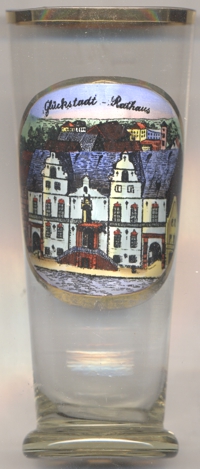

|
| DEUTSCHLAND | GERMANY |
| Bundesland: Schleswig-Holstein | |
| Kreis: Steinburg |
 Glückstadt is situated at the right bank of the Lower Elbe river, about 46 km northwest of Hamburg
and about 75 km southwest of Schleswig-Holstein's capital, Kiel. The municipality has a population of about
10,700 (2021).
Glückstadt is situated at the right bank of the Lower Elbe river, about 46 km northwest of Hamburg
and about 75 km southwest of Schleswig-Holstein's capital, Kiel. The municipality has a population of about
10,700 (2021).
Glückstadt (literally 'fortune city') was founded in 1617 on the marsh lands along the Elbe by the Duke of Holstein, King Christian IV of Denmark, who had levees and fortifications built as well as a ducal residence. As Christian IV promised the settlers tax exemption and freedom of religion, Glückstadt soon became an important trading centre, intended to compete with the Imperial city of Hamburg, located upstream on the Elbe. Calvinists, Remonstrants and Mennonites (Anabaptists) from the Netherlands settled here, as well as Sephardic Jews and Catholics. After the king had interfered in the Thirty Years' War (1618–1648), the town in 1627/28 was besieged for fifteen weeks by the united Imperial and Catholic troops, though without success. In 1649 Christian’s son and successor King Frederik III of Denmark had the seat of the Holstein administration moved to Glückstadt, whereafter the duchy became known as Holstein-Glückstadt. In 1773 the town became the capital of all Holstein lands, when the lands of the Holstein-Gottorp line were finally incorporated. During the War of the Sixth Coalition in 1814 Glückstadt was blockaded by the allies and capitulated, whereupon its fortifications were demolished. In 1830 it was made a free port. Holstein-Glückstadt remained a possession of the Danish Crown until its defeat in the Second Schleswig War of 1864. It was occupied by Austria, but finally incorporated into the Prussian Province of Schleswig-Holstein in the aftermath of the 1866 Austro-Prussian War.
The  town hall goes back to a prior town hall that was built in 1642–1643 in Nordic Renaissance style. By the
19th century that building had become instable and therefore it was mostly broken off in the 19th century and was rebuilt in 1873–1874
following the original design.
town hall goes back to a prior town hall that was built in 1642–1643 in Nordic Renaissance style. By the
19th century that building had become instable and therefore it was mostly broken off in the 19th century and was rebuilt in 1873–1874
following the original design.
[https://de.wikipedia.org/wiki/Gl%C3%BCckstadt, https://en.wikipedia.org/wiki/Gl%C3%BCckstadt;
https://de.wikipedia.org/wiki/Rathaus_(Gl%C3%BCckstadt)]
![[scale]](lineal.jpg)